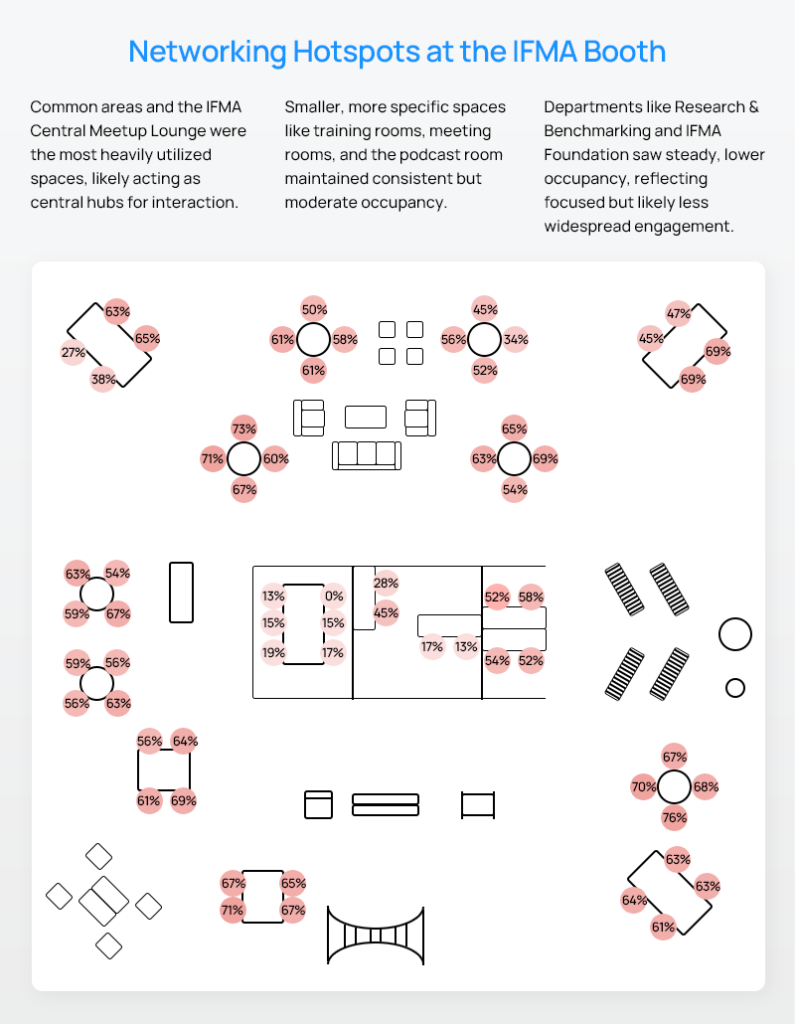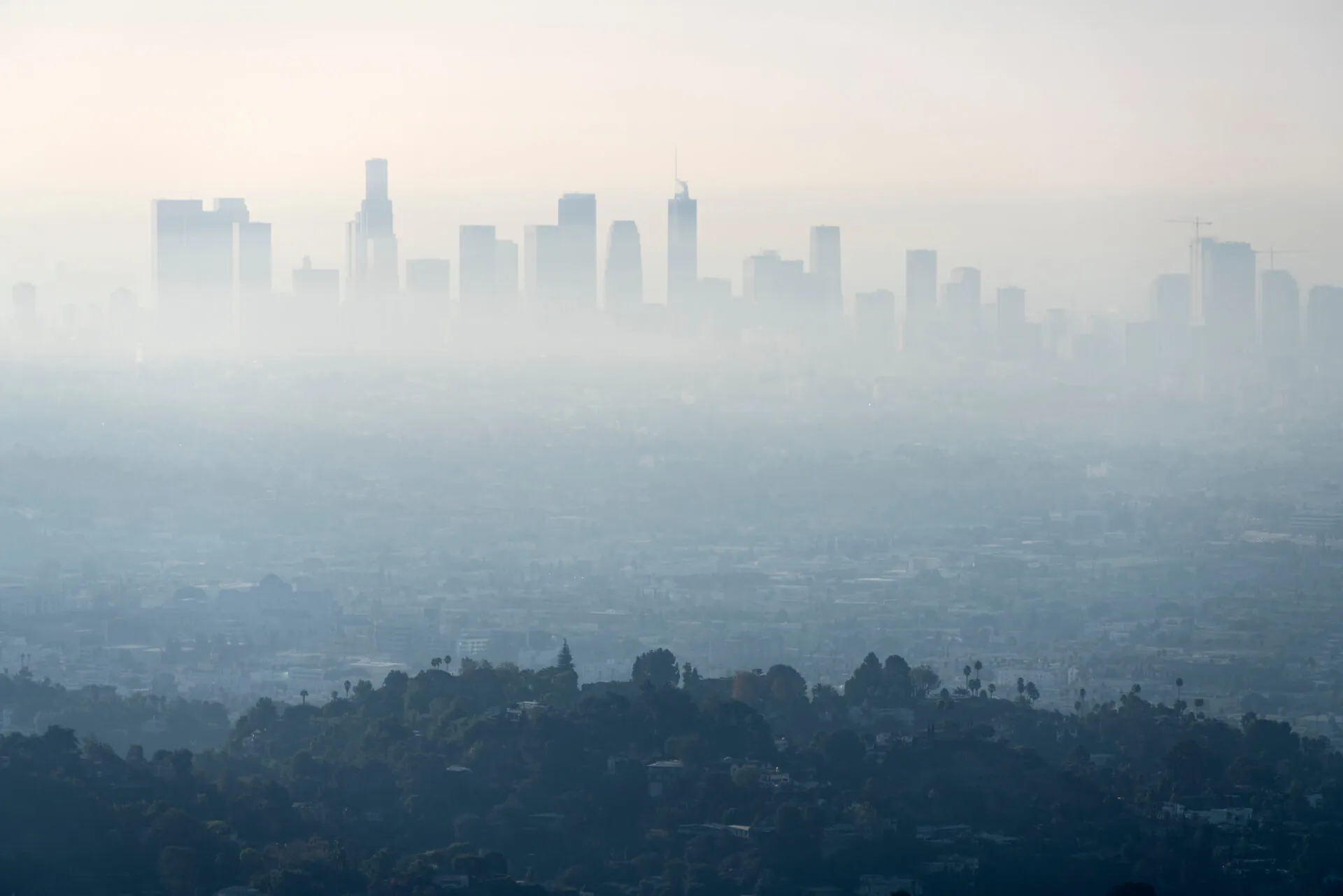Space Utilization and Comfort in Focus at IFMA World Workplace 2024
At this year’s IFMA World Workplace event, R-Zero installed its cutting-edge sensor technology to gather key metrics on space utilization and environmental comfort at the IFMA event headquarters, to provide a clear picture of how attendees interacted with various spaces and how air quality and comfort parameters held up in a high-traffic environment.
Utilization Insights: How Booth Space Was Used

The data revealed an average seat utilization of 58%, meaning just over half of available seating was consistently in use. This indicates a balanced attendance flow, with some room for increased engagement. At peak times, however, utilization surged to 88%, showing high demand and effective space management.
Occupancy data showed that, on average, 37 seats were used simultaneously during the event. This metric is valuable for understanding how spaces like booths and meeting areas were utilized, helping IFMA understand how to optimize layouts for future events to encourage networking and comfort. Additionally, the average dwell time reached up to 42 minutes during peak periods, providing insights into engagement levels and attendee interest.
Networking Hotspots at IFMA

One of the most insightful aspects of our data analysis was identifying the event’s networking hotspots. Common areas, like the IFMA Central Meetup Lounge, saw the heaviest use, acting as hubs for attendee interactions. Smaller spaces, such as training rooms and meeting rooms, experienced moderate yet steady occupancy, suggesting consistent engagement for specialized sessions. Departments with focused activities, like Research & Benchmarking, saw lower but steady traffic, likely due to the specific interest of attendees.
Mapping these hotspots helps illustrate how different zones attract varying levels of attention and interaction, which can inform future booth designs and event layouts to foster even better engagement.
Air Quality and Comfort Metrics

Comfort isn’t just about space; it’s also about creating a comfortable and pleasant environment. Our IAQ Monitor captured a range of environmental data, revealing that temperature remained stable, averaging 72.2°F, indicating reliable HVAC performance.
However, CO₂ levels reached a peak of 1283 ppm—a level that could have impacted occupant comfort if sustained. This insight highlights the importance of monitoring indoor air quality, particularly in enclosed, high-traffic spaces.
The VOC Index peaked at 225 ppm, indicating elevated levels of airborne chemicals, likely due to furniture, materials, or occupant density. Monitoring VOCs is crucial as it helps maintain air quality standards and reduce potential discomfort for occupants.
Leveraging Data for Future Events
The data gathered at IFMA World Workplace 2024 emphasizes the power of digitization in building management and event planning. Understanding space utilization trends and environmental metrics allows us to make informed decisions that enhance attendee experience, optimize energy use, and create comfortable, engaging environments.
For facility managers and event organizers, insights like these are invaluable. By using real-time data on space utilization and environmental factors, they can fine-tune layouts, adjust environmental controls, and ensure that every square foot serves its purpose effectively.
To discover how R-Zero’s solution can elevate your space, reach out to us today.
More posts you might like
-

3 Key Takeaways from AHR Expo 2025: What’s Shaping the Future of HVAC
The 2025 AHR Expo brought together HVAC industry leaders, innovators, and professionals to showcase the latest advancements in heating, ventilation, and air conditioning. Here are the key insights that stood out from our team on the ground. 1. Smart Technology is Enhancing, Not Replacing, Traditional HVAC A significant shift observed at this year’s expo is […]
-

Webinar Recap: Redefining Energy Efficiency
As commercial energy costs continue to rise, building operators are looking for faster, cost-effective solutions to reduce waste and improve efficiency. Heating, Ventilation, and Air Conditioning (HVAC) systems account for nearly 60-70% of total building energy consumption, making them one of the largest opportunities for savings. However, traditional HVAC systems often operate on outdated schedules, […]
-

Wildfire Smoke: Understanding the Impact on Indoor Air Quality
As we face yet another intense wildfire season, with significant events already impacting regions across the country, the challenges to air quality, both outdoors and indoors, are more pressing than ever. Wildfires contribute up to 50% of “ultrafine” particles in the air; tiny pollutants that can travel hundreds of miles and infiltrate indoor spaces, affecting […]

